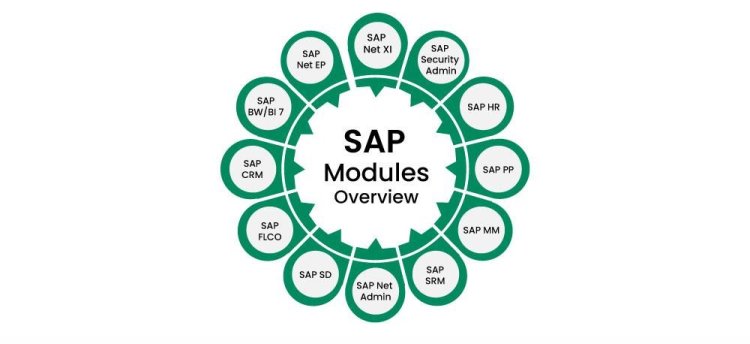How to Plan Your SAP S/4HANA Implementation for Maximum Efficiency
Learn how to effectively plan your SAP S/4HANA implementation. Follow our guide to ensure maximum efficiency and streamlined business operations.

SAP S/4HANA Implementation can be a drastic initiative for any business. This helps in automating the business processes, improving the business analytics and helping in making faster and better decisions when needed. But to reach a successful S/4HANA implementation, which is the focus of this paper, requires some planning, competent people, and good project management. This paper aims to review the key steps and strategies in the efficient S/4HANA implementation process, regarding project design, data transfer process, and organizational change management, as well as training of users.
SAP S/4HANA Modules
SAP S/4HANA cloud is the sophisticated and highly centralized version of the ERP system that is developed based on the SAP HANA in-memory computing platform. It offers a comprehensive suite of business applications designed to manage various aspects of an organization, including:
- Finance: Simplifies the financial operations and merges information into a single database to support actual time reports.
- Logistics: Improves procurement, production planning control and material management encompassing supply chain aspects, storage and warehousing.
- Manufacturing: Optimizes production process, and speeds up the quality control and the monitoring of the production process.
- Human Capital Management (HCM): Covers the most important and general human resources activities such as recruitment and selection of employees, processing of payments, human capital management, and more.
- Customer Relationship Management (CRM): Offers solutions for lead and sale management customer service and support.
S/4HANA Implementation Steps
To understand the process of SAP S/4HANA implementation, it is necessary to refer to the implementation process characterized by the corresponding phases.
1. Project Planning and Business Case Definition:
- Define Clear Objectives and Strategy: Among global best practices, it is recommended to develop a clear business case that would state the goals and objectives of implementing SAP S/4HANA Cloud.
- Assemble a Dedicated Project Team: Select team members from different departments that you believe would be useful for the project such as the finance department, the logistics department, the IT department, and the human resources department.
2. Project Scope Definition and Resource Allocation:
- Define Implementation Scope: The first step in your deployment of S/4HANA should involve identifying and effectively outlining the project’s scope. This includes decisions on which SAP S/4HANA modules to implement, which business processes to address and geographical areas that would be dealing with.
- Resource Allocation: Identify and secure the appropriate resources which can include financial, temporal, personnel and skill resources. Make sure you have a qualified staff who will understand the S/4HANA solution and be capable of implementing it as per the organization’s needs.
3. Data Assessment, Cleansing, and Migration:
- Data Assessment and Cleansing: Assess the quality and validity of all the data that you have extracted from all the potential source systems. This may include factors such as eliminating inconsistency, duplication, and inaccuracies of data.
- Data Mapping and Conversion: The next step is to identify in which of the SAP S/4HANA modules the legacy data can be input, and then match it again with the fields that were identified previously. Identify what data transformation rules pertain to the ongoing business and use data mapping tools to ease the data conversion process.
4. Infrastructure and Hardware Planning:
- Evaluate Hardware Requirements: Speak to your hardware personnel to review your hardware infrastructure needs for the SAP S/4HANA cloud system. The third is the hardware requirements; make sure that your computers and servers meet SAP’s guidelines for computing power, RAM, and memory to meet the demands of an in-memory database platform.
- Deployment Option Selection: It is now time to decide on the deployment option you want for S/4HANA. You can opt for an on-premise implementation, cloud-based implementation on SAP HEC or implement a hybrid model that is a combination of on-premise and cloud.
5. Licensing and Contract Negotiation:
- Secure Appropriate Licensing: To integrate with SAP S/4HANA you need to have the right licenses to match the modules to be implemented, the number of users and the deployment model- On-premise, cloud or hybrid.
- Review and Negotiate Contracts: Before signing up or renewing SAP S/4HANA licensing agreements with SAP or authorized SAP partners ensure that you critically study and/or negotiate the T&Cs.
6. System Configuration and Customization:
- Configure Core S/4HANA Settings: Set up general system parameters of SAP S/4HANA including the company codes, the chart of accounts, the fiscal year, and business partners. Make sure that these configurations correspond with the particularities of your accounting environment and enterprise’s activities.
- Customize Workflows and User Interface: SAP S/4HANA offers an easy-to-use Fiori interface and it should be used to manage different business processes and users’ preferences.
7. Testing and User Training:
- Develop a Comprehensive Testing Plan: The testing plan must include unit testing, integration testing, system testing, and user acceptance testing (UAT). Ensuring a new system is free from errors means that testing has to be conducted to completion to ensure all bugs and problems are detected before implementing..
- User Training and Change Management: Conduct a user training program to enhance the understanding of the employees to use the new S/4HANA system properly.
8. Go-Live and Post-Go-Live Support:
- Go-Live Strategy and Cutover Plan: Take time to put in a clear go-live plan as well as a cutover plan to use when migrating from the old system to S/4HANA. It should cover the details of data copy in the disaster recovery site.
- Post-Go-Live Support and Monitoring: After going live, continue to engage the users and support them as they relate to the implementation project. Other components of the proposal should have proper communication channels that will be used in case of receiving queries from the users or if they encounter any problems while using the MOS.
Conclusion
SAP S/4HANA implementation is not an easy task, however, if best practices are followed, proper planning is done, and the right attention is paid to project management, an organization can go a long way in doing the implementation successfully. What is important to remember is that a good plan and a good business case coupled with a team of professional implementers, proper data conversion and transfer solutions together with well-executed and planned training. If these steps are followed diligently and aligned with the requirements of your organization, the SAP S/4HANA cloud can be effectively utilized to its full potential and pave the way for your company’s success in the future.
What's Your Reaction?

































